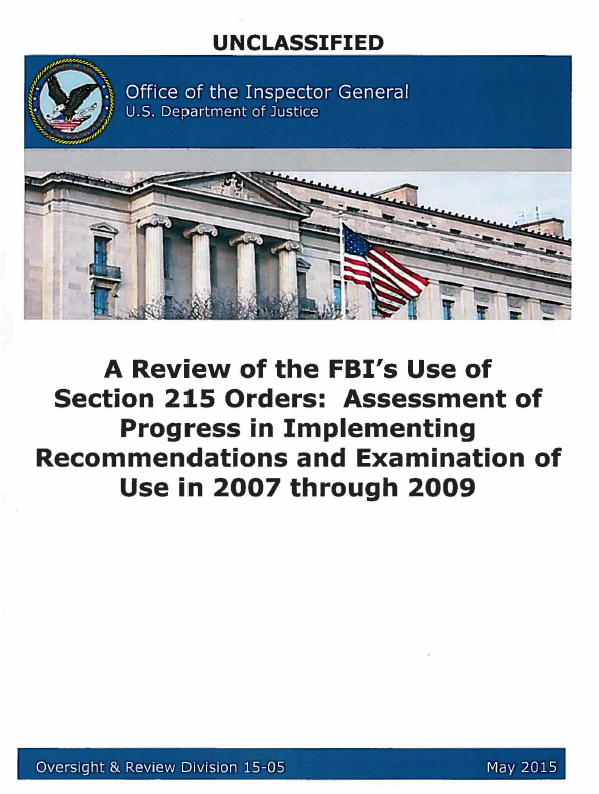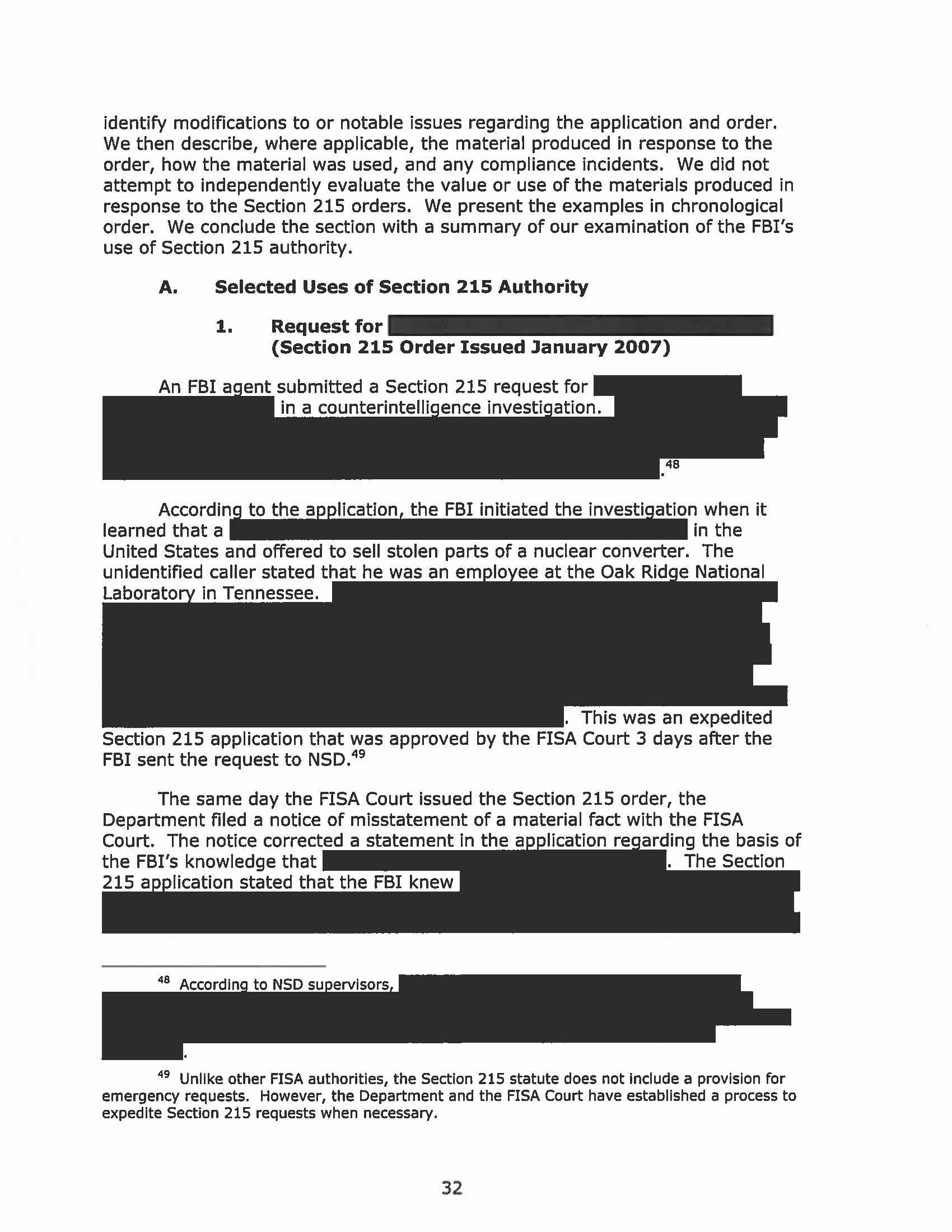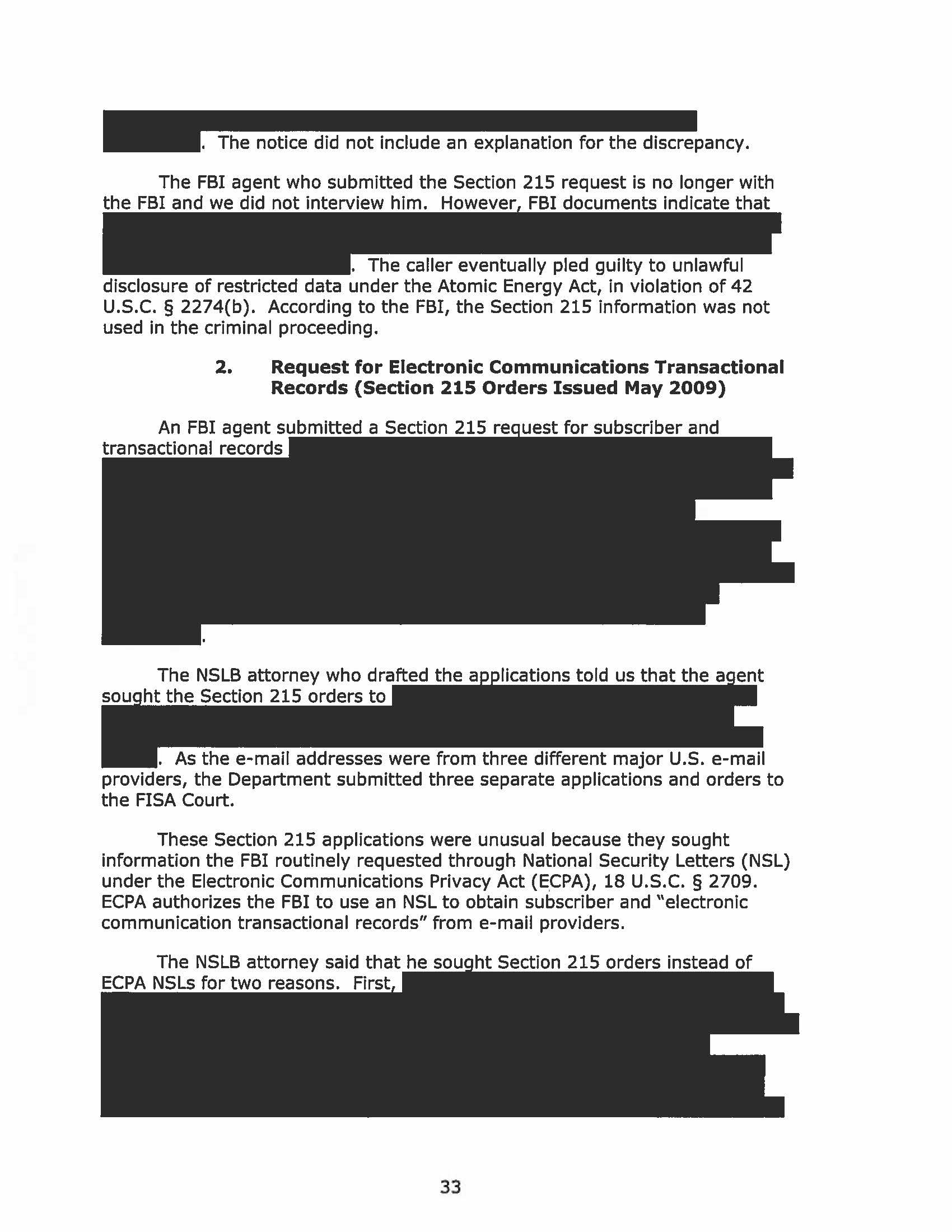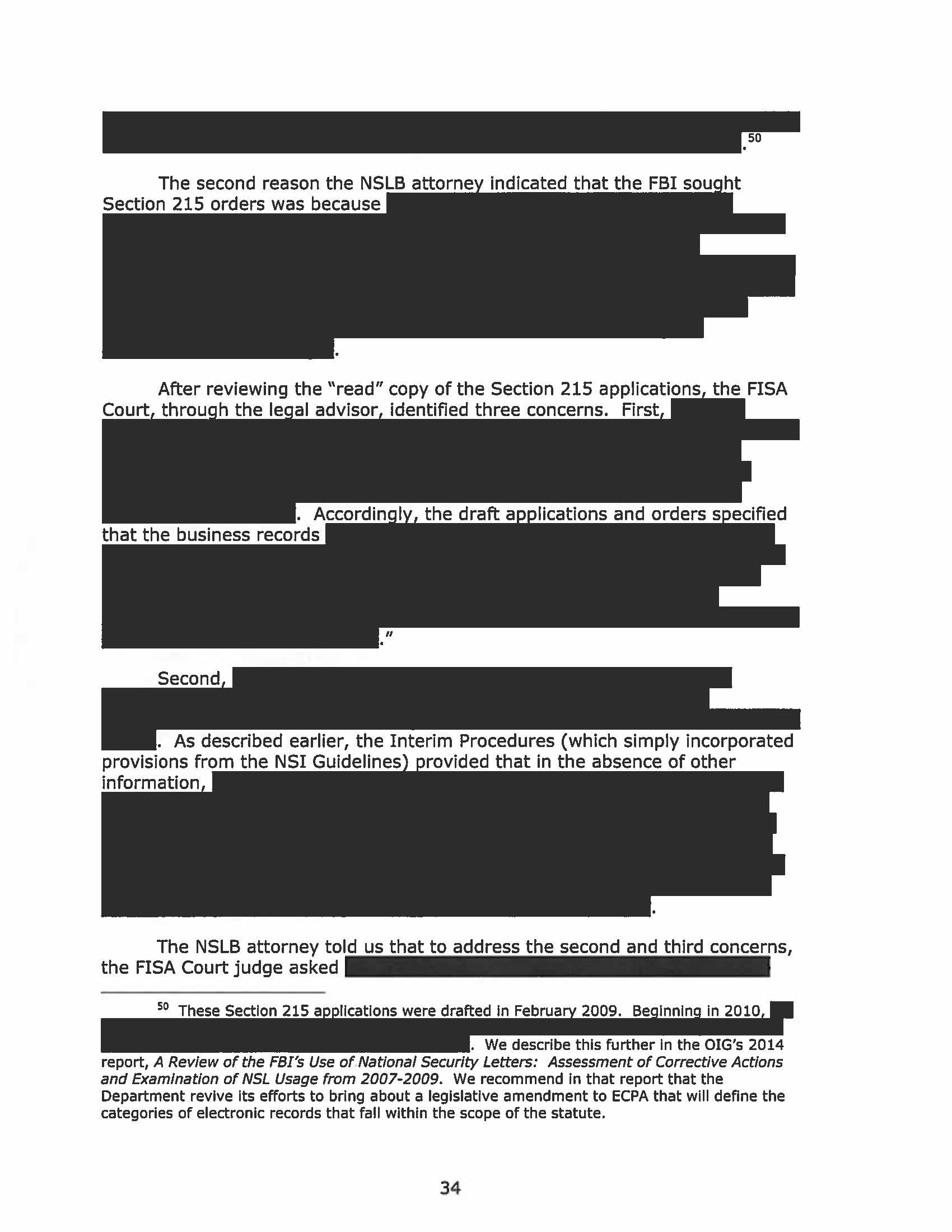The following Inspector General report was released by the Department of Justice on May 21, 2015.
A Review of the FBI’s Use of Section 215 Orders: Assessment of Progress in Implementing Recommendations and Examination of Use in 2007 through 2009
- 77 pages
- May 2015
- 23 MB
This Executive Summary provides a brief overview of the results of the Department of Justice (Department or DOJ) Office of the Inspector General’s (OIG) third review of the Federal Bureau of Investigation’s (FBI) use of the investigative authority granted by Section 215 of the Patriot Act. Section 215 is often referred to as the “business record” provision. The OIG’s first report, A Review of the Federal Bureau of Investigation’s Use of Section 215 Orders for Business Records, was issued in March 2007 and covered calendar years 2002 through 2005. The OIG’s second report, A Review of the FBI’s Use of Section 215 Orders for Business Records in 2006, was issued in March 2008 and covered calendar year 2006. This third review was initiated to examine the progress the Department and the FBI have made in addressing the OIG recommendations which were included in our second report. We also reviewed the FBI’s use of Section 215 authority in calendar years 2007, 2008, and 2009.
To conduct this review, the OIG reviewed the Standard Minimization Procedures for Tangible Things Obtained Pursuant to Title V of the Foreign Intelligence Surveillance Act adopted by the Attorney General on March 7, 2013. We also examined over 10,000 documents obtained from the FBI and the Department’s National Security Division’s (NSD) Office of Intelligence, including files relating to each of the FBI’s applications to use Section 215 authority, and Department reports to Congress concerning that use during calendar years 2007 through 2009. We interviewed over 50 individuals from the FBI and the Department, including Section Chiefs from the FBI’s National Security Law Branch (NSLB) and NSD’s Office of Intelligence as well as the attorneys, case agents, and analysts who worked on individual Section 215 orders.
In this review, we examined the progress the Department and the FBI have made in addressing the three recommendations in the OIG’s March 2008 report. In the 2008 report, we recommended that the Department implement minimization procedures for the handling of nonpublicly available information concerning U.S. persons produced in response to Section 215 orders, as required by the Reauthorization Act. We also recommended that the FBI develop procedures for reviewing materials received in response to Section 215 orders to ensure that the materials do not contain information outside the scope of the Foreign Intelligence Surveillance Court (FISA Court or the Court) orders. Finally, we recommended that the FBI develop procedures for handling material that is produced in response to, but outside the scope of, a Section 215 order.
The Reauthorization Act required that the Department adopt minimization procedures to govern the retention and dissemination of material produced pursuant to a Section 215 order. In response to the statutory requirement, the Department adopted Interim Minimization Procedures in September 2006. The Interim Procedures adopted four sections of the FBI’s National Security Investigation Guidelines (NSI Guidelines) and stated that the four sections were to be “construed” to meet the statutory definitions of minimization procedures contained in the Reauthorization Act. FBI agents were already required to comply with the NSI Guidelines in their entirety when seeking a Section 215 order and handling Section 215 productions. Thus, the Interim Procedures did not add any new requirements and did not affect the application of the NSI Guidelines to Section 215 material.
In our March 2008 report, we found that the Interim Procedures did not meet the requirements of the Reauthorization Act because they failed to provide FBI agents with specific guidance regarding the retention and dissemination of non-public U.S. person information obtained under Section 215 authority. We therefore recommended that the FBI develop final standard minimization procedures for business records that provided such guidance. In response to our report, the Department stated that it would replace the Interim Procedures with standard minimization procedures “specifically tailored to collection under Section 215.”
As we describe in our current report, our review of the FBI’s Implementation of this recommendation revealed that the Department had not yet replaced the Interim Procedures by mid-2009. Beginning in June 2009, FISA Court judges began to issue Supplemental Orders with Section 215 orders. The Supplemental Orders required the Department to submit a written report to the FISA Court describing the FBI’s implementation of the Interim Procedures to U.S. person information produced in response to Section 215 orders. The Supplemental Orders also required that the reports be of sufficient detail to allow the FISA Court to assess the adequacy of the implementation of the Interim Procedures. NSD and NSLB attorneys told us that they believed that the FISA Court judges would continue to issue Supplemental Orders until the Department replaced the Interim Procedures with final procedures specifically designed for Section 215 matters.
We found the Supplemental Orders significant because the practice began almost 3 years after the Department was required by the Reauthorization Act to adopt specific minimization procedures for material produced in response to Section 215 orders, and over a year after we found that the Interim Procedures implemented by the Department in September 2006 failed to meet the requirements of the Reauthorization Act. The Department and FBI ultimately produced final minimization procedures specifically designed for Section 215 materials in 2013. The Attorney General adopted the FBI Standard Minimization Procedures for Tangible Things Obtained Pursuant to Title V of the Foreign Intelligence Surveillance Act on March 7, 2013 (Final Procedures), and In August 2013 the Department began to file Section 215 applications with the FISA Court which stated that the FBI would apply the Final Procedures to the Section 215 productions.
Given the significance of minimization procedures in the Reauthorization Act, we do not believe it should have taken 7 years for the Department to develop minimization procedures or 5 years to address the OIG recommendation that the Department comply with the statutory requirement to develop specific minimization procedures designed for business records. Nevertheless, as we describe in our report, we concluded that with the Final Procedures the Department and FBI have addressed the three recommendations in the OIG’s March 2008 report. With respect to our recommendation that the Department develop final standard minimization procedures, we consider the recommendation to be closed.
…
B. The Process for Seeking Section 215 Orders
As we described in our first and second Section 215 reports, the process to obtain a Section 215 order generally involves five phases: FBI field office initiation and review, FBI Headquarters review, NSD Office of Intelligence review, FISA Court review, and FBI service of the order.
The process to obtain a Section 215 order generally begins when an FBI case agent in a field office prepares a business records request form, which requires the agent to provide, among other things, the following information: a brief summary of the investigation, a specific description of the items requested, an explanation of the manner in which the requested items are expected to provide relevant information, and the identity of the custodian or owner of the requested items. The request form must be approved by the agent’s supervisor and the field office’s Chief Division Counsel and Special Agent in Charge. The approval process is automated through the FBI’s FISA Management System (FISAMS), which sends electronic notifications to each individual responsible for taking the next action in order to process the business record in the field office. After the approvals are completed In the field office, the FISAMS notifies the “substantive desk” (in the Counterterrorism Division or Counterintelligence Division) at FBI Headquarters.
At FBI Headquarters, the business records request form is reviewed and approved by both the substantive desk and NSLB. Once the FISAMS delivers the request to the substantive desk, it is assigned to an NSLB attorney who works with the case agent and other FBI personnel to obtain the information the NSLB attorney believes is necessary to include in the draft application and order. The draft application package is then reviewed by NSLB supervisors and forwarded to NSD, where the request is assigned to an NSD attorney.
The NSD attorney works with the NSLB attorney, case agents, and occasionally FBI intelligence analysts to obtain any additional information the NSD attorney believes is necessary to include in the draft application and order.13 An NSD supervisor then reviews the draft application package. The final application package is returned to the FBI for an accuracy review and additional edits may be made based on the FBI’s review of the final package. Upon completion of the final version, signatures of designated senior FBI personnel are obtained and an NSD attorney prepares the package for presentation to the FISA Court.
While the final signatures are collected, NSD schedules the case on the FISA Court’s docket and, pursuant to the FISA Court Rules of Procedure, provides the FISA Court with a “proposed application” which is an advance copy of the application commonly called a “read” copy. The FISA Court, through a FISA Court legal advisor, may identify questions or concerns and request changes or additional information to the documents after reviewing the “read” copy. NSD and the FBI then address these questions or concerns and make any necessary revisions to the application and order prior to submitting a formal or final application and order for the Court’s approval. The FISA Court will either sign the formal submission or request that NSD present the formal application package to the FISA Court at a scheduled hearing. If the FISA Court judge approves the formal application, the judge signs the order. The judge may make handwritten changes to the order (for example, to clarify the U.S. person status of the person or entity for which the records were sought) and, if so, will sign the order with the handwritten modifications.
The order is then entered into the FISAMS and served by the FBI field office nearest to the provider designated in the order. Among other things, the order sets forth the deadline for producing the items.
…




